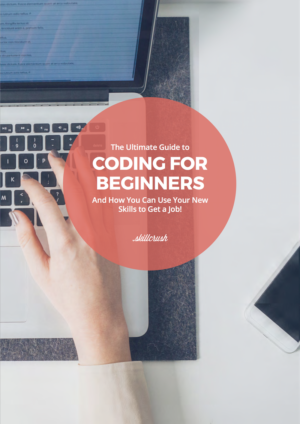
Get Our Free Ultimate Guide to Coding for Beginners
Make a plan for learning the tech skills you need to land a new job with this 60+ page FREE ebook!
While a sore neck or aching back is a surefire sign that it’s time to stand up, stretch, and take a break from working at your desk, it’s harder to notice when your eyes need a rest—that is until you suddenly have a mystery headache or find it hard to focus on the text on your screen. Headaches, inability to focus, dry eyes, and increased sensitivity to light are all symptoms of eye strain, a condition that’s inevitable when looking at a computer screen without breaks or precautions.
Fortunately for all us computer-bound workers, eye strain is preventable and mitigable. With a little planning and a few free and relatively inexpensive tools, you can give your eyes the rest and care they need. Here’s a list of seven essential tools—both gear and apps—designed to protect your eyes from the pain of strain.
1. Anti-Glare Filters
As inspiring as windows (and their much needed natural light) can be in a workspace, windows positioned either behind your desk or in front of your monitor are actually eye killers. One option to avoid this is to configure your workspace away from front or back facing windows, but that isn’t always possible. Luckily, an anti-glare filter can help bridge the gap and provide your eyes with relief. Anti-glare filters are clear, removable panels that fit over your computer screen and help prevent glare from sunlight or other light sources. These filters come in sizes specific to standard monitor dimensions—19 inch, 22 inch, 24 inch, etc.—as well as sizes specific to product types like laptops and tablets.
Try this Anti-Glare Filter from Amazon, be sure to measure your screen and pick a size that fits your needs!
Price: $22.05
2. Bias Lighting
Just as natural light from windows can cause problems for your eyes, artificial light can strain your vision depending on where it’s coming from—which is why you need to be intentional about your lighting set up. Bias lighting is lighting situated behind your monitor that increases ambient light around your screen without shining more light directly into your already tired eyes. This softens the effect of your bright computer screen in contrast with the dimmer lights in the of the rest of your room (a contrast that leads directly to vision fatigue).
Try the Luminoodle bias lighting is an adhesive strip that attaches to the back of your monitor, providing that ambient light that will give your tired eyes a break. Price: $9.99
3. Adjustable Monitor Mounts
Whether your monitor is too close to your eyes, too far away, or in a position that causes you to crane your neck (adding neck strain and back strain to the mix), bad monitor placement can ruin your whole day. An adjustable mount clamps to your desk and allows you to attach a monitor (or in some cases, multiple monitors) by way of detachable brackets. You can then adjust the stand to the height and distance that works best for your eyes (and neck, and back!) at any given time.
Try the Vivo mount, which can accommodate two screens up to 27 inches in size. Price: $29.99
4. Computer Glasses
“Blue light” refers to the type of light associated with computer monitors that scatters easier than other kinds of visible light, making it more noisy and unfocused than natural light (and harder for the eye to process). Blue-light-blocking computer glasses are designed with tinted lenses to filter that light and reduce the amount of strain that blue light puts on your eyes.
Try the Cyxus Semi-Rimless Computer Glasses that claim to filter blue light by as much as 90 percent, cutting down on the blurriness and headaches that can come from vision fatigue. Price: $19.90
5. F.lux
As F.lux’s developers say, computer screens are designed to look like the sun, which is great at certain points of the day but in the evening or the middle of the night staring into that bright light isn’t so easy on the eyes. F.lux is an app compatible with all major desktop platforms that adjusts the color of your computer screen according to the time of day, tamping down glare in the evening hours.
Price: Free
6. Stretchly
We all know taking periodic breaks to stretch and get away from our screens is a crucial part of maintaining overall health and well-being (including our vision), but it’s so easy to breeze through the day and forget about taking those breaks. While there are a number of break-oriented apps out there, Stretchly is available for all platforms and it’s free. Stretchly runs in the background on your desktop and opens a window every ten and 30 minutes reminding you to take “microbreaks” and five minute breaks respectively. Simple but effective, Stretchly is like a self care alarm clock for your eyes and the rest of your body, too.
Price: Free
7. iReader
Good web design is a bonafide art form, but sometimes the colorful videos, menus, and banners can start to take a toll on your vision. If a site’s text is the main thing you’re interested in and you want to give your eyes a break, give iReader a try. iReader is a Chrome and Firefox compatible extension that can break down web pages to a simple text and image layout, making it easier to digest if all you’re doing is reading. Using Safari instead of Chrome or Firefox? In that case, the same features you’ll find in iReader are built directly into your browser. Look for the line-style icon on the left hand side of your URL bar, click on it to enter Reader Mode, and the page you’re visiting will be streamlined for maximum eye-care.
Price: Free

Get Our Free Ultimate Guide to Coding for Beginners
Make a plan for learning the tech skills you need to land a new job with this 60+ page FREE ebook!

